April arrived and brought an explosion of foliage and flowers, along with nesting Blue Tits, Starlings and for a brief time Coal Tits but we think they have abandoned their nest. And somewhere in the undergrowth hidden from view a Mallard duck made a nest too.
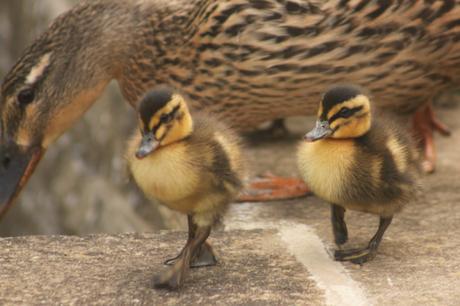
Mallard Duck Chicks up on our patio
We are separated from a tributary to the River Flit by the 15 meter width of my neighbours garden. Our boundary is mostly made up of a solid fence but at one point about 30 metres of trellis and chain link fence, this lets more light into my garden and as we like each other a little lack of privacy is fine by us both. The trellis supports old roses and ivy.
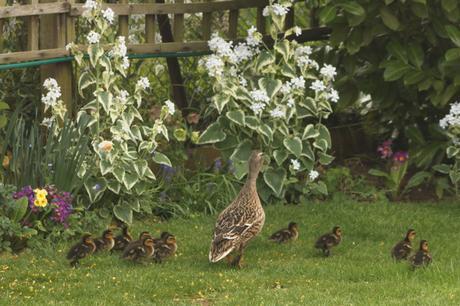
Looking for a gap in the fence to take her chicks to water
But Mother Duck having nested and succesfully hatched 12 chicks in our garden, could now not find a gap through our fence to cross my neighbours garden to the river tributary. So she led all 12 for over an hour, stopping now and again for a rest. The chicks could hop through the chain link fence, but she could not get through to join them and would not fly up and over. Eventually I helped and made a hole big enough for her to get through too. Meanwhile….
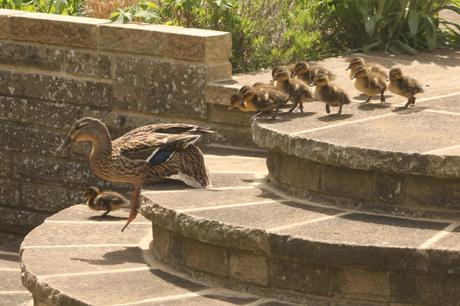
Leading her children down the patio steps
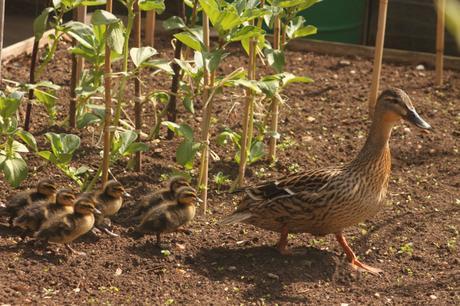
She led her children through the bean and pea bed.
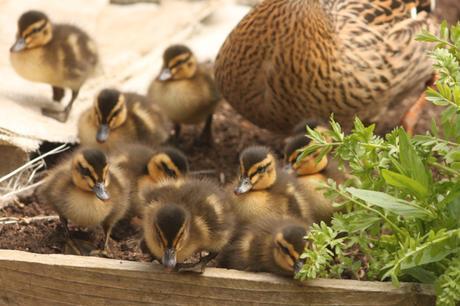
They stopped and explored my untidy vegetable garden and did a little light weeding
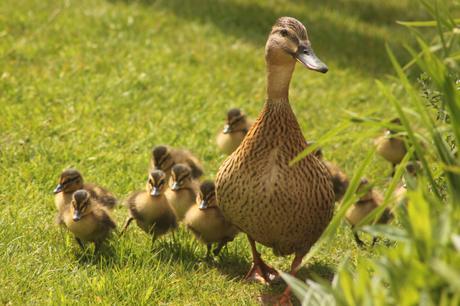
Then looking relaxed she led them back across the lawn
And finally after finding the newly made hole she led her chicks across my neighbours lawn under her hedge and into the river tributary. Sadly, I know she will have hatched 12 chicks as there is a high percentage some will be predated.
Other visitors included 7 spot ladybirds. Although the 7 spot is among the most common Ladybird in the UK they are under threat from Harlequins. Originally introduced from Asia to Europe for commercial crop control Harlequins have spread to the UK arriving in 2004. 7 Spot Ladybirds sleep or are dormant through the winter, emerging from March to May to mate and reproduce. One 7 spot eats 5,000 aphids in their year long life.
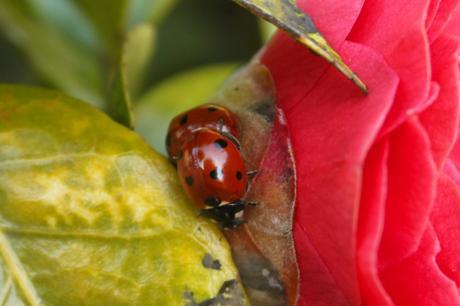
Gardeners friends – 7 spot native Ladybirds
Harlequins also eat aphids but add in lacewings, hoverflies and other ladybirds. To monitor the spread the Harlequin Ladybird Survey run by UK Ladybirds are asking for sightings to be recorded. UK Ladybirds is also a very helpful website if you would like help with identification and to record native ladybird sightings too.
There were Bees and Butterflies, but I have been slow to capture any in a photograph. Brimstones, Orange Tips, Small Tortoiseshells and Green Veined Whites have all been spotted in our garden this month. I have an exposed garden so usually we see more Butterflies here from late June onwards after they have laid eggs, hatched, pupated and emerged than in April but apparently we have just enjoyed the sunniest April since records began in 1929, hence some early visitors for me.
At the beginning of April, before the leaves burst forth, a friendly female blackbird who would normally feed on the ground made the unusual move and hopped up to sit outside the dining room window on a branch of Hydrangea petiolaris. She pecked at the fat blocks, I had hoped she would sing here too, do female blackbirds sing or is it just the males? but instead just gave me a close-up to admire. The blackbird song is my favourite, making my heart soar every time. To hear the blackbird song on the BTO website click here.

Female Blackbird
The birdsong this month has been especially loud and magical and sometimes so loud its startling. The Robin is usually first to sing and they focus on singing whilst waiting for enough light to forage. Most mornings we are woken around 5 by a dawn chorus, just as well there is so much to do!

Robin singing
Please visit Tina’s blog at My Gardener Says who hosts this monthly meme for more Wildlife Wednesday posts from across the world. A bit of wildlife watching is so good for the soul.
